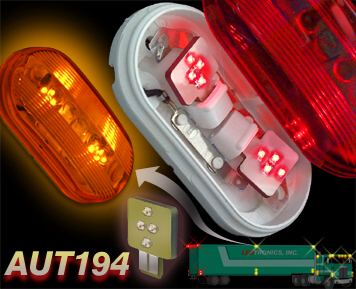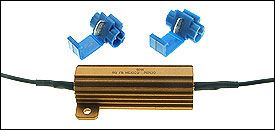Shortly after I got my electric truck, I decided to put in LED brake lights and taillights. My thought was that they would use less power and (although minuscule) improve my range. This was not the case; however, LEDs turned out the be the right idea for a different reason.
I picked up the LEDs at a local auto parts store. They fit, they turned on; everything looked correct until I hit the turn signal. It blinked at an annoyingly fast pace. After some searching online I found out that the LEDs have a different (lower) impedance than the traditional bulbs. The difference in impedance made the flasher unit in my truck think the bulb was shorted. And because of the lower resistance, these were actually using more power.
I lamented my findings to an EV mailing list. The replies were helpful, others had similar issues and there were solutions. Furthermore, the real reason to retro fit with LEDs was not power, but the speed with which they turn on. LEDs light up about a fifth to a third of a second quicker than standard incandescent light bulbs. That may not sound like much, but at 65 MPH, a vehicle covers 19 feet in a fifth of a second. This could be the difference between a severe crash and a fender bender or the guy behind you stopping just in time and you avoiding the dreaded call to your insurance agent. You can actually see the difference in the time that it takes for LEDs vs old bulbs to come on in this EvNut video.
Reignited, I found there were 3 possible solutions to the quick flashing issue.

- Get LEDs with "legacy impedance"
- Get a new LED-ready flasher unit
- Install a resister in series with the LEDs
Trying these in the above order, I looked for legacy impedance LEDs that fit my truck. I found a company had made them at one point but they were bought and that line was discontinued. Moving down the list, I had no luck finding an LED ready flasher unit. I was able to find them for other Chevy's but not a 1998 S-10.
That left me with just option 3. I was thinking that I was going to have to get a multi-meter and make a trip to RadioShack. Luckily the product I needed already existed, complete with frame mountable heat-sink packaging.
After installing this 6 Ohm, 50 W resistor, the blink rate returned to normal. And despite my occasionally slow hypermiling driving, I have not been rear-ended.
LEDs cost more, but they last a lot longer and if they prevent an accident, it is money well spent.
LEDtronics Products > Automotive
enjoy
LEDtronics Products > Automotive
enjoy





No comments:
Post a Comment
Note: Only a member of this blog may post a comment.